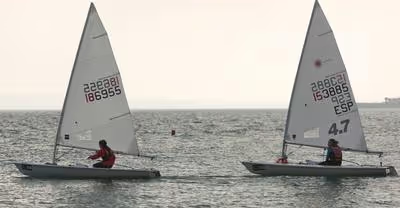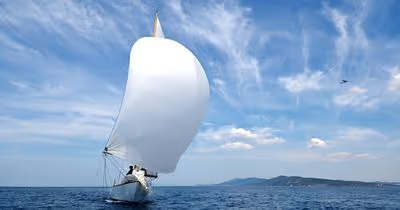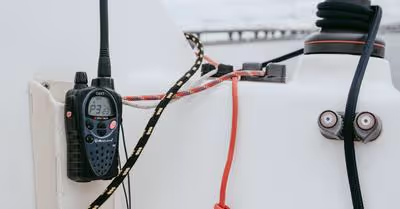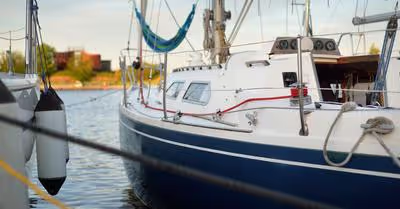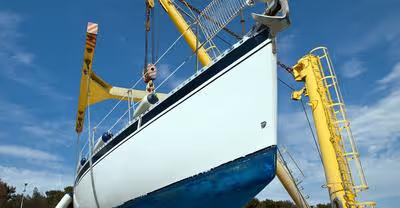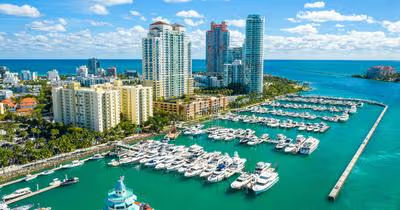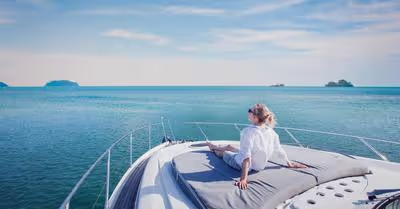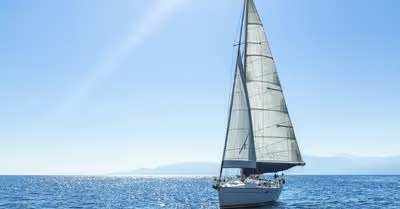Table of Contents
Rudder Types
With the four rudder types mentioned, each one will have its pros and cons. As you begin your travels on bluewater or are interested in learning more, then it would not hurt to check out what each rudder is designed to do.
Full Keel Rudder
If you were to picture a sailboat with a rudder, it would likely be a full keel rudder. The most common rudder type is the full since a lot of sailboats use a full keel.
The reason a full keel is the most common keel on a sailboat is that it is the best one to provide stability. In that case, you need a rudder that can accommodate that type of boat.
On a full keel sailboat, the rudder looks like it is part of the keel itself. It is actually attached on a hinge, giving it the appearance that it is fully connected to the keel.
Advantages of a Full Keel Rudder
A full keel rudder is quite strong and actually helps tremendously with the protection of the boat. During a strong storm or harsh waves, it can be easier to navigate with this type of rudder. In addition, debris is significantly less likely to snag on anything like other rudders.
Disadvantages of a Full Keel Rudder
While a full keel rudder might be the best one to handle in strong storms, it is still the most difficult rudder to handle. Since the flow of the water is providing pressure on the full keel, it makes it harder to move the rudder. You would need to put a lot of effort into steering, especially in harsher conditions.
Skeg Rudders
Skeg rudders might give a full keel rudder a run for its money due to its durability. These are often referred to as skeg mounted rudders.
These are similar to full keel rudders, but can also be used on fin keel boats. This alone gives it a slight edge over full keel rudders, but each boat design will differ.
Advantages of a Skeg Rudder
With similarities to a full keel rudder, you are going to have the stability as well in a skeg rudder. The added bonus is that it works in either a full keel boat and a fin keel.
Disadvantages of a Skeg Rudder
Just like a full keel rudder, all of the pressure of the water hits on one side or the other. This means it will be hard to turn in rough conditions.
Spade Rudders
These rudder types are best fit for a fin keel boat rather than a full keel or to the types of boats. It enters straight down into the water and can rotate left or right using a post that extends within the hull.
Advantages of a Spade Rudder
The best advantage of a spade rudder is that it can be part of the fin keel. You can turn this rudder much easier than a full keel rudder or skeg rudder. The water is not forced one side or the other, allowing a better flow and easier turn.
Disadvantages of a Spade Rudder
If you sail upon a lot of debris in the water, you are likely going to damage the rudder. These are more delicate than skeg or full keel rudders, as they are more exposed.
Debris can get caught in between and potentially wrapped within the space rudder. In addition, rough water can be a nightmare. Tough conditions can cause enough pressure to bend or potentially break the rudder.
Outboard Rudder
Outboard rudders are not attached to the boat’s hull and are mounted outside at the back. Typically, these are not connected to a steering wheel and are connected by a tiller.
A tiller is a steering lever that can take some getting used to if you have solely used steering wheels. On smaller boats, sailors actually like a tiller over a wheel.
Advantages of an Outboard Rudder
If an outboard rudder becomes damaged, it will not typically affect the rest of the boat. This is because there is not a rudder post through the hull.
In the event that you damage it while at sea, you have the opportunity to fix it. Since it is on hinges and not attached to the hull, it might be able to be fixed. This also means the rudder might be stronger than other rudder types.
Disadvantages of an Outboard Rudder
Since the outboard rudder is at the back of the boat, it is vulnerable in some situations. If floating debris or something like a rope is in the water, it can tangle up in the rudder or damage it.
The location of the rudder also makes it harder to turn than a spade rudder. In tough conditions, this might be difficult to turn.
Purpose of a Rudder
A rudder is one of many important components of a boat to operate as efficiently as possible. Some boats are built for speed and others for comfort, so a rudder also has to fit that category.
Water pressure will dictate how the rudder moves in the water. Whichever direction you turn the rudder, then water pressure will push against it and allow you to turn.
While a sailboat is turning, it is pivoting around a middle point of the boat. The stern and bow move at the same time, while the middle point of the boat remains in place. Knowing how to properly operate a rudder to steer can make a huge difference in avoiding a crash.
Variations of Rudders
While some rudders are fairly cut and dry for their intended use, other rudders have slight variations to the design. This allows a little bit of flexibility on some boats, which is great because not all boats are designed the same.
Balanced Rudder
A balanced rudder is a form of a spade rudder with a slight difference in free space at the top. The leading edge allows rotation from one side of the boat while the trailing edge goes opposite.
The post is also a few inches back from the front of the rudder, which is slightly different from a regular spade rudder. Even though the turning action is roughly the same in comparison to a spade rudder, the force on the helm has more balance and makes it easier to steer.
You will usually see this type of rudder in performance boats or yachts. Furthermore, they are always paired with a fin keel to provide the best performance overall.
The only drawbacks to a balanced rudder is that it is susceptible to debris if you were to run anything over in the water. You have to rely on the structural integrity and hope that it is strong enough to take a blow. If it were to fail, it does not revert back to the center and might make it difficult to navigate the boat.
Unbalanced Rudders
Unbalanced rudders have the support from a full length skeg and are attached to the furthermost point of their span. It is unbalanced because the entire rudder is aft of its axis or the centerline where the rudder stock is located.
When you begin turning this rudder type, you get all of the force on one side. Whoever is steering the boat will notice this feeling compared to other rudder types, especially when using a tiller.
As you can gather, these rudder types are not commonly used today. You might find one used in history books or replicas of older boats.
If this were commonly in use today and were to fail at sea, the rudder remains in place and not go back to the centerline. This caused serious issues in the past and arguably why it is not very popular anymore.
Semi-balanced Rudders
If you can picture what a balanced and unbalanced rudder would look like, then a semi-balanced rudder is something in between. The name suggests that it is partially balanced and unbalanced at times.
The top part of the rudder is unbalanced, while the lower part is balanced. With the top part being this way, it helps by providing structural support to the rudder by aiding in vertical displacement.
During this process, the balanced section will endure less torque pressure during swings. It will then return back to the centerline if the steering equipment fails, which is a critical aspect that balanced and unbalanced rudders did not originally have.
Semi-balanced rudders are also different from other types since they vary in size and shape. You will often hear sailors talk about the depth of the horn, which is the connection between the rudder and the boat.
A shallow horn rudder has a horn that extends less than half of the chord length from its top. In a deep horn rudder, the horn extends more than 50 percent of its chord length from the top.
Semi-balanced rudders have had some unique innovations over the years. They appear to be the best of both worlds between balanced and unbalanced.
Twin Rudders
Twin rudders have been used since 1980 among racing boats. Over the last decade or so, they have increased in popularity among cruising sailboats.
Twin rudders have a history of being difficult to operate in tight spaces if you do not have experience with them. This is true, especially since it navigates a little differently than one rudder.
When using a boat that has a twin rudder, the prop wash moves by both rudders and you cannot have the same maneuverability as with one rudder. One tactic you could do is to increase your boat speed to increase water flowing between the rudders. In doing so, it could cause some concern in tight spaces if you are unable to land exactly where you want.
One positive to twin rudders is that it performs well in reverse. You do not have as much prop walk as other boats and can handle better in lower speeds due to increased blade length on both rudders.
Another benefit is that it responds better to the wind. In single rudder boats, the wind can push the bow in one direction while the stern goes opposite. For twin rudders, the wind does not have as much of an impact in that regard.
Can Rudders Fail While in Use?
Just like anything in life that you use, it has a lifespan on it. For a rudder, some can fail while you are using them at sea.
Rudders failing at sea is actually a common hazard, so knowing what to do in that situation is very important. Sometimes cheaper boats, like a fiberglass boat, will experience a rudder failure likely before a more expensive boat.
The material of the rudder pole has to be a good blend of flexibility and strength. If it is too weak, it will break. If it is too strong, it might damage the hull since it cannot flex properly.
The framework inside the rudder should be a heavy-duty metal, because if it breaks, then it will be unusable. This is likely the case in cheaper boats, where costs have been cut in certain areas. Depending on the boat brand, you might see welding jobs that are not executed properly for rudders.
In addition, the type of rudder you use at sea can make a big difference. Full keel rudders might be the best option since it is protected from debris and offers the best stability. Depending on your sailing goals, the right rudder type will be different for everyone.
What are Rudders and Stocks Made out of?
Rudders have historically been crafted out of heavy duty stainless steel or aluminum. You want something that is non-corrosive and can withstand some beating.
If you were to look at high performance yachts, these typically have alloy since it is lighter but also strong. Stainless steel can handle swelling and debris, but crevice corrosion could be an issue.
Composite is another material that is used in mass production yachts or high performance boats. Some material is arguably better than others, but there is really not a perfect option out there. A proper inspection is needed before doing any long term use at sea.
Why a Tiller Could be Better than a Wheel for Rudders
If you have sailed a boat with a steering wheel and have never used a tiller, you could be missing out. Regardless if you are new to sailing or a seasoned pro, a tiller is very easy to use.
Tillers provide instant feedback when turning a boat, whereas steering wheels take a minute to get results. For newer sailors, a wheel could prove to be frustrating in rough conditions.
Depending on the size of your boat, a wheel might be the better option. In larger boats, a tiller does not perform the same.
Even though a tiller is harder to turn, it still offers an immediate reaction. This is why you will oftentimes see tillers on racing boats because they provide instant feedback.
What Happens if Your Rudder Fails?
While safety is a priority in everything you do while sailing, there are some situations you cannot avoid. No matter how much preventative maintenance you do, your rudder might still become damaged or unable to use.
If bearings have seized, the rudder can become difficult to move at first but will eventually lock up. Your steering capability will eventually be impossible and quite difficult to stop the boat from rounding into the wind.
If it were to fall off completely, then you will have quite a difficult time tracking the boat. The rotation of the boat might even be abrupt or rapid.
It is important to stay calm during a situation like this and to check on the crew. Drop your sails and attempt to gain some control.
You could even try pointing the bow into the wind and dropping anchor to reduce motion. Once the boat is under control, check for damage and call for assistance.
If you cannot phone for assistance, the best thing you can do is to create a makeshift rudder or potentially purchase one before a situation like this happens. For example, brands like Seabrake and Delta Drogue are quality rudders you could use in a pinch to safely make it back to shore.
Recent Articles



